
- AMERICA'S CUP
- CLASSIFIEDS
- NEWSLETTERS
- SUBMIT NEWS


Arkéa Ultim Challenge - Actual Ultim 3 leads - Positions, Images and Video from Day 1
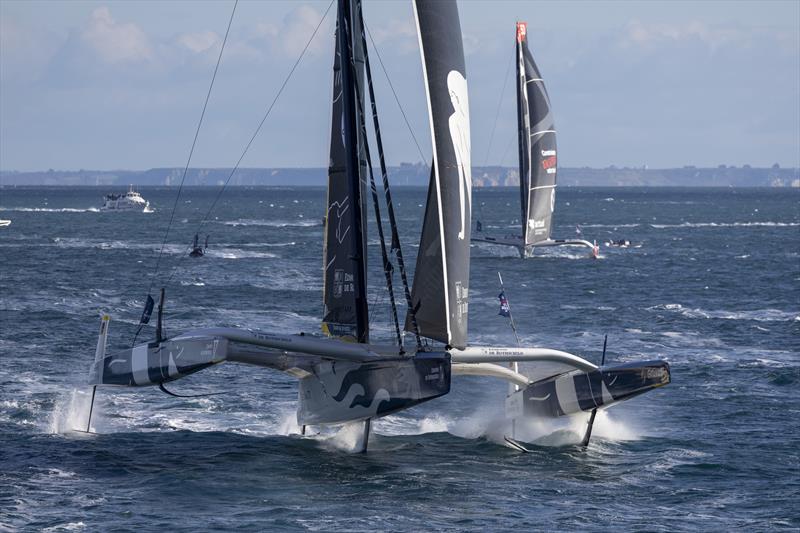
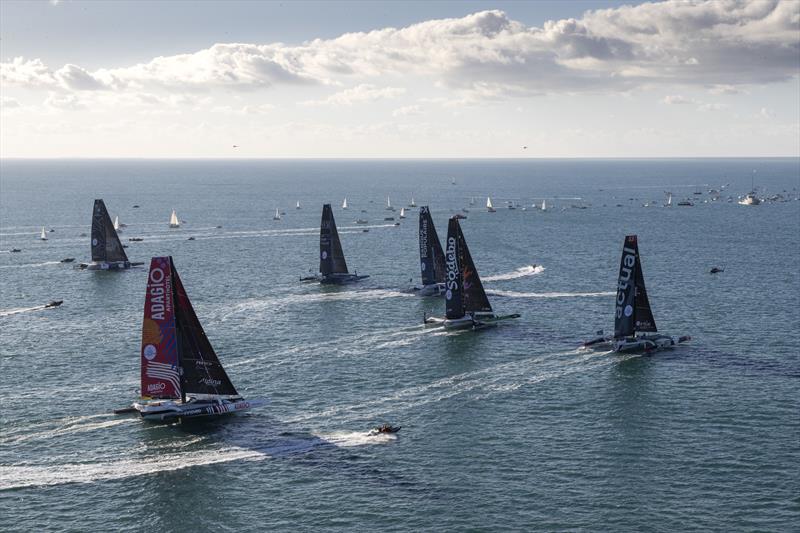
Related Articles
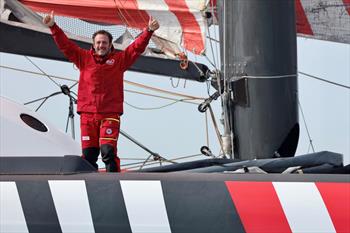
- AROUND THE SAILING WORLD
- BOAT OF THE YEAR
- Email Newsletters
- America’s Cup
- St. Petersburg
- Caribbean Championship
- Boating Safety
- Ultimate Boat Giveaway

The Supreme Soloists of the Ultimes
- By James Boyd
- January 9, 2024
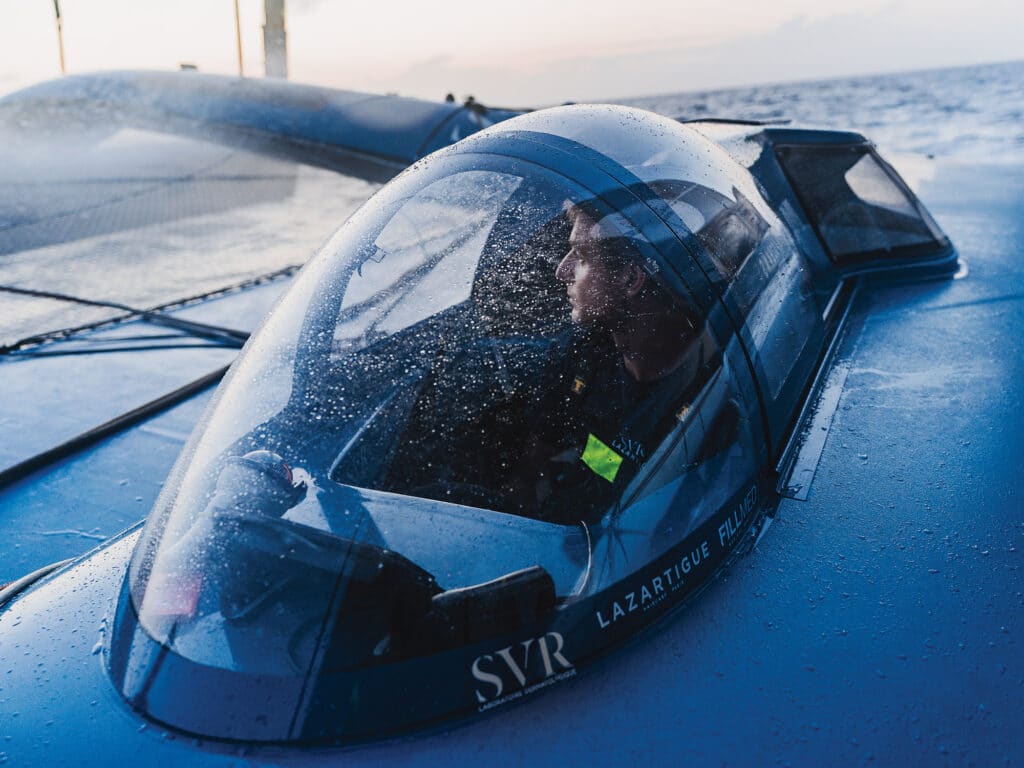
On January 7, ocean racing will take another evolutionary step with the mind-boggling feat of six brave Frenchmen who will set off from Brest in northwest France on board their giant 105-by-75-foot foiling trimarans—around the world, nonstop. Singlehanded. The new event is the Arkea Ultim Challenge-Brest, a sprint marathon that is expected to take 45 days or less at an average of 20 knots.
The present record for a solo lap of the planet stands at 42 days, 16 hours, 40 minutes, 35 seconds, but when this was set in 2018, skipper François Gabart had the luxury of departing with an optimal 10-day forecast (covering the first quarter of his voyage all the way down to the Southern Ocean). Competitors in the Arkea Ultim Challenge-Brest will have to leave on the designated start date and make the best of whatever Mother Nature offers them. However, while Gabart’s MACIF trimaran is going again (in new livery as Anthony Marchand’s Actual Ultim 3 ), it is now one of the older of the six trimarans that will set out. The newest Ultims, which harness the latest offshore foiling technology, are much, much faster.
Two of the biggest names in solo round-the-world record-breaking will be missing from the lineup; Gabart has passed over the helm of his Ultim to “the next generation” in Tom Laperche. Francis Joyon, who demolished the record for the solo lap on two occasions, bringing it down from 125 days to 72 days in 2005 and from 71 days to 57 days four years later, is now 67. While all six starting skippers are highly experienced, they range in age from 55-year-old Thomas Coville, skipper of Sodebo Ultim 3 , to 26-year-old Laperche.
Coville is the race titan. When it comes to racing large trimarans around the world singlehanded, his experience is unprecedented. He’s been attempting circumnavigation records on large trimarans since 1997 and as a skipper since 2008. On his fifth attempt in 2016, he finally set a new record only for it to be broken a year later by Gabart. He also has raced in the America’s Cup and the Volvo Ocean Race (winning it with Franck Cammas on Groupama in 2011-12) and was twice part of crews claiming the Jules Verne Trophy (fully crewed, nonstop around-the-world record). He has completed circumnavigations eight times—four times solo and six times on trimarans.
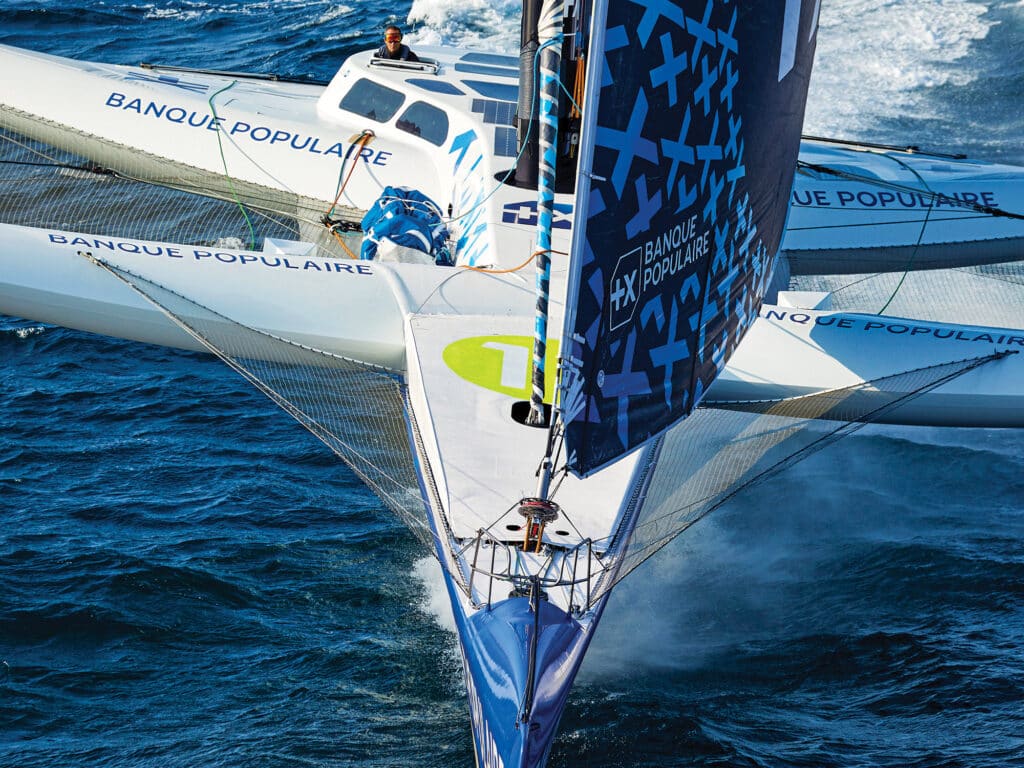
The most hotly tipped skippers, however, are Armel le Cléac’h, 46, on Maxi Banque Populaire XI, and Charles Caudrelier, 49, on Maxi Edmond de Rothschild . While Caudrelier is best known for being a two-time Volvo Ocean Race winner (with Groupama , then as skipper of Dongfeng Race Team in 2017-18), both cut their teeth solo racing in the French one-design Figaro circuit. But when it comes to solo offshore credentials, Le Cléac’h knocks it out of the park. He’s won La Solitaire three times, most recently in 2020, and crucially for the upcoming Arkea Ultim Challenge-Brest has also raced in three Vendée Globe races, finishing on the podium in all and winning in 2016-17.
Le Cléac’h’s trimaran was launched in 2021 as a replacement for his previous Banque Populaire-backed Ultim, which broke up terminally in the 2018 Route du Rhum. Maxi Edmond de Rothschild is unique in the race for being designed by Guillaume Verdier, while the rest are from VPLP (although in every case, the team itself offers substantial input). While Caudrelier has won most Ultim silverware in recent seasons, including the singlehanded Route du Rhum trans-Atlantic race in 2022, Le Cléac’h ended his run by winning this fall’s Transat Jacques Vabre race between Le Havre in northern France and the French Caribbean island of Martinique.
Tom Laperche has taken over as skipper of Francois Gabart’s SVR-Lazartigue for solo races. This is Gabart’s second Ultim trimaran and is considered the most advanced of the six. Laperche won La Solitaire du Figaro in 2022 and has raced with Gabart on the Ultim ever since the boat was launched. He gained his round-the-world experience on the IMOCA Holcim in The Ocean Race.
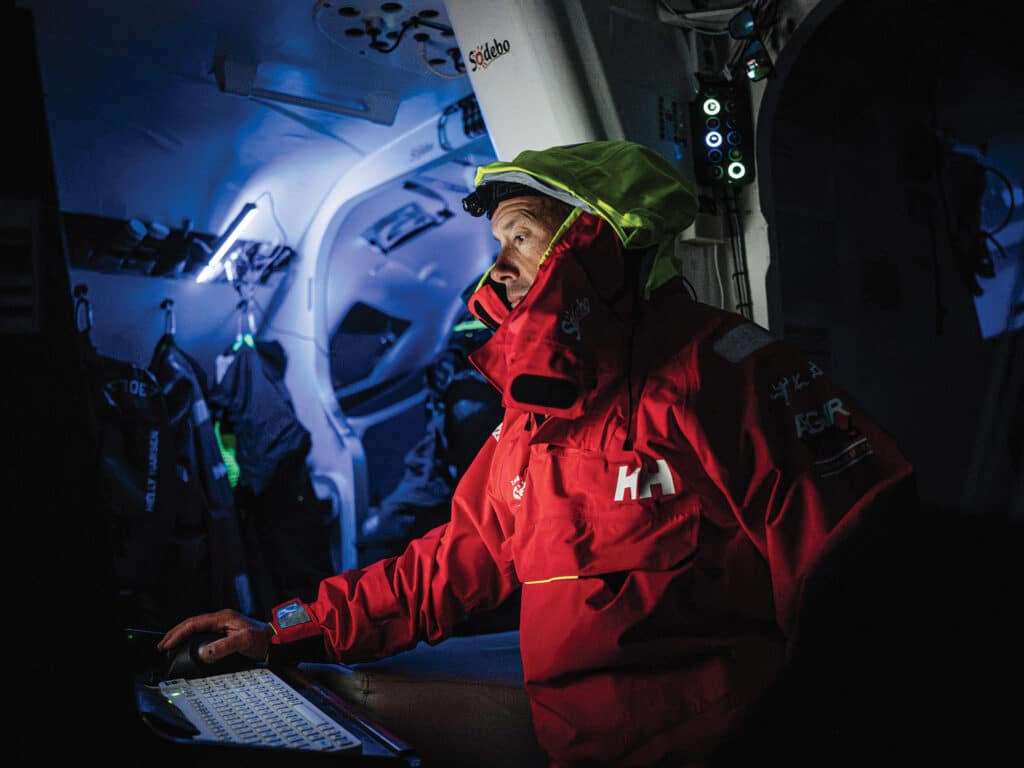
Also inheriting his Ultim campaign is Anthony Marchand, who took over the helm of Actual Ultim 3 from Yves le Blevec in January. Launched in 2015, Actual Ultim 3 is Gabart’s former MACIF trimaran, which is the present holder of the solo round-the-world record. Marchand, 38, sets off with vast experience on ORMA 60 trimarans, in the Figaro class, the Volvo Ocean Race (competing in 2015-16 on MAPFRE ) and in the IMOCA.
Fundamentally, the rule limits length to 32 meters and width to 23 meters, and the complex foil configuration on all six Ultims is fairly similar.
Éric Péron, 42, is the race’s last-minute entry, and as a newcomer to the Ultim class, he will likely back marker. Péron has a strong background in the Figaro and Ocean 50 trimaran classes, and his trimaran Adagio was previously Sodebo Ultim , on which Coville set both his solo round-the-world and west-to-east trans-Atlantic records.
While there is an Ultim 32/23 rule, the design parameters of these incredible machines is a work in progress. Fundamentally, the rule limits length to 32 meters and width to 23 meters. The complex foil configuration on all six Ultims is fairly similar. Each of the boats has six appendages, including the giant, retracting rake-adjustable J-foils (of varying shapes) in the floats. The latest-generation foils have grown larger, enabling the trimarans to fly both downwind and upwind in less wind. Among the three front-runners, the most recent edition of the Transat Jacques Vabre demonstrated that SVR-Lazartigue has the lowest take-off speed, while Maxi Banque Populaire XI ’s foils work best in waves. Maxi Edmond de Rothschild lies somewhere between these two positions.
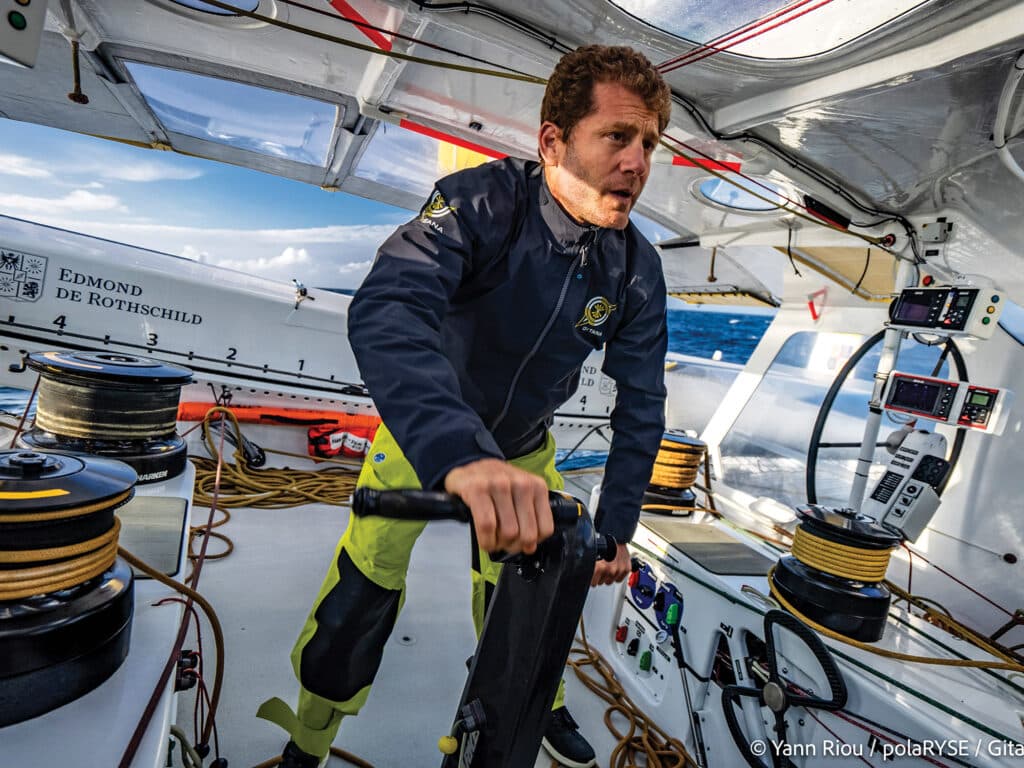
Unique to the Ultims is the T-foil pioneered by Caudrelier’s team on their MOD70 (now Giovanni Soldini’s Maserati ). Located in the center hull, this is effectively a daggerboard with a trim tab (to aid pointing ability upwind) and an elevator. This foil is used in a similar fashion to how AC50 catamaran crews negatively raked their windward rudder elevator to produce downforce, sucking the weather hull down. When a gust hits an Ultim, the crew can drop the traveler, but a more energy efficient response is to increase pitch on the T-foil’s elevator to create additional downforce. Then there are three rudders (one on each hull), each with an elevator. The rudders in the floats can be raised (typically the windward one) to reduce drag.
Aside from the significant developments to the foils, especially to reduce cavitation at high speed, teams have been focusing on improving aerodynamic efficiency. The Ultims now have low-drag vinyl fairings for the aft side of their crossbeams, and on some boats, the deck itself forms an endplate for the foot of sails. Living quarters have improved dramatically and, like modern IMOCAs, are becoming increasingly enclosed. The most extreme among them is Sodebo Ultim 3 , where the front of Coville’s “bridge” is forward of the mast step.
Autopilots have transcended beyond being able to steer to course, apparent wind angle or even true wind angle. Depending on the point of sail, the pilot will now automatically head up or bear away when a gust hits.
The rigs are the same as those that have been fitted to French multihulls for the past 30 years—a rotating wing mast with each shroud terminating in a giant hydraulic ram, permitting the rig (and its center of effort) to be canted to weather. This reduces the downward force on the leeward bow, which can cause multihulls to pitchpole. Whether this is still required is a moot point because today’s foils effectively keep the leeward bow from immersing.
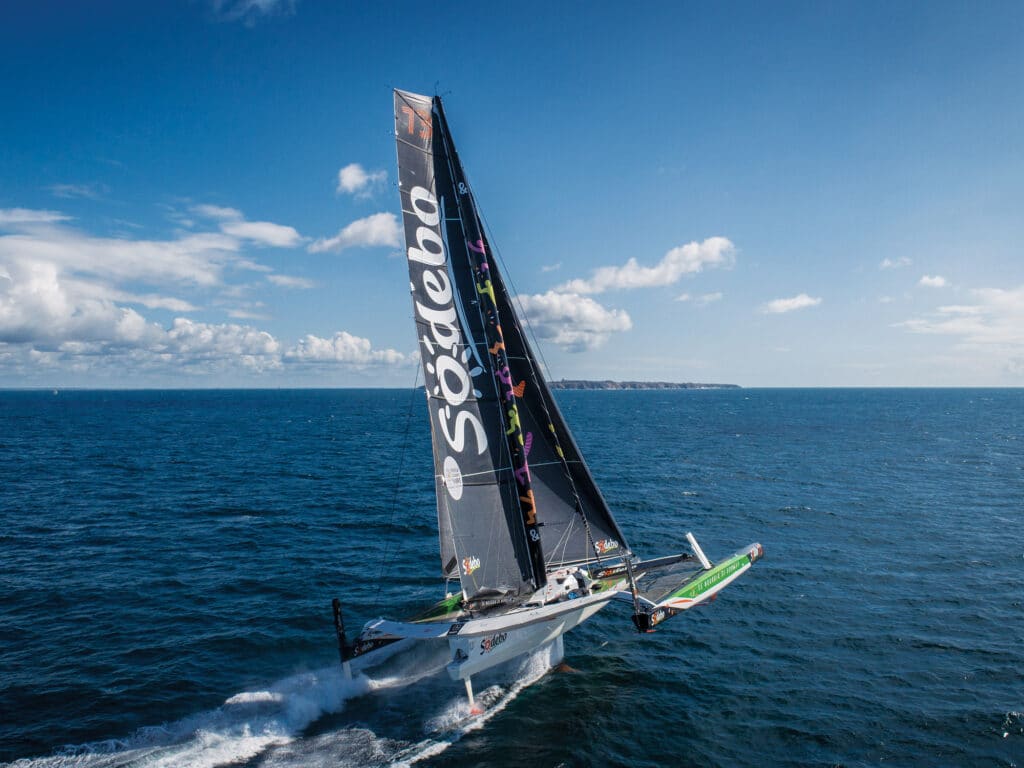
Due to the sheer physics of an Ultim, aided by the canting rig and the mast being stepped so far aft, the risk of capsize is almost nonexistent, Caudrelier says: “The Ultims are the safest multihulls because they fly, because they are big, but also because we have made huge improvements to the pilots with safety functions, and also we have a nice automatic system to ease the sails. It is quite safe. I don’t worry too much about capsizing, but I have in the back of my mind that it can happen.”
Thanks to teams working with such companies as B&G and Pixel sur Mer, Ultim autopilots have transcended beyond being able to steer to course, apparent wind angle or even true wind angle. Depending on the point of sail, the pilot (using what’s referred to as its “safety overlay”) will now automatically head up or bear away when a gust hits, which it can detect by the wind instruments or an inclinometer. In extreme circumstances, they have systems to dump the sheets, although these too seem to be near-redundant.
An interesting point of dispute between the Ultim teams is how much automation should be permitted. Caudrelier’s team is pro automation, while other teams are less so. As a result, the autopilot can perform these functions but cannot, for example, adjust the boat’s flying mechanism, to automatically set ride height, pitch, etc.
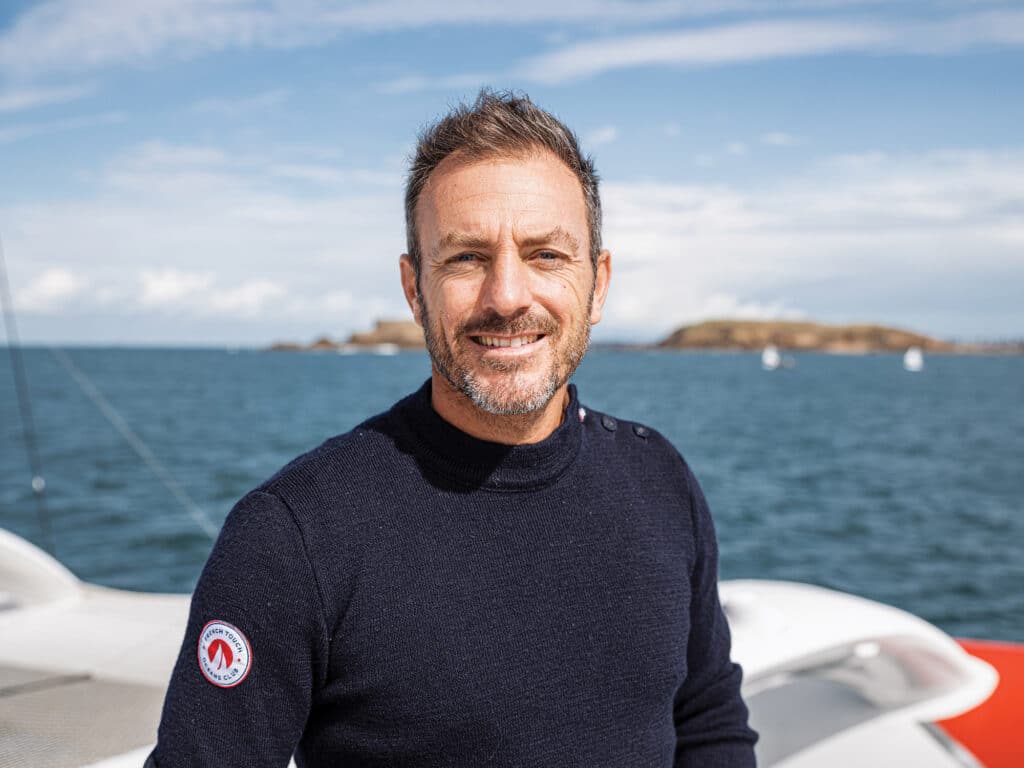
If capsize is less of a concern, then the skipper’s biggest worries are technical failures on their giant boats, as well as collisions. They have tried to overcome the former through sheer time at sea, testing and failing to improve reliability. Le Cléac’h, for example, says that in the past year, he has sailed Maxi Banque Populaire XI some 20,000 miles, or half a circumnavigation. This has been solo and crewed, in a mix of races, private sea trials and the Ultim fleet training en masse. To avoid collisions, the Ultims have all available kit from radar to AIS alarms to the latest tech such as SEA.AI, which uses a masthead-mounted camera array to see objects—floating or semisubmerged—in the water ahead of the boat. These are compared in real time with the SEA.AI’s huge and ever-growing database of objects to identify them as threats.
In the recent Transat Jacques Vabre, Maxi Edmond de Rothschild suffered rudder issues soon after the start (later found to be a delaminating starboard rudder) and then damage to its port J-foil, but it still finished the race. It seems, therefore, very likely that this level of attrition can be expected in the Arkea Ultim Challenge-Brest. Caudrelier says that this proved to be a wake-up call for his team as well as valuable practice for how to deal with midrace technical issues. For example, the J-foil damage occurred after a small impact. “But while we were sailing, the damage increased,” he says. Perhaps it would have been faster in the long term to stop, fix the issue, and then continue, he muses. For bigger issues, race’s sailing instructions permit skippers to pitstop where their teams can join them to effect repairs, but in this case, they are obliged to spend a minimum of 24 hours in port as a penalty.
To help reduce risks, OC Sport Pen Duick, the race’s organizers, are imposing a movable virtual ice barrier as we have seen in other round-the-world races. Competitors must stay north of this, regardless of whether it drives them into high pressure or storms. Interestingly, they are also imposing exclusion zones around known breeding grounds for whales (yet to be defined at the time of writing).
The Arkea Ultim Challenge-Brest may be a solo race, but each campaign is genuinely a team affair. Ultim teams today are giant, some the scale of America’s Cup teams two or three decades ago, with their own in-house designers, engineers, hydro and aerodynamic specialists, and electronic and hydraulic experts. In the event of a technical issue during the race, skippers can now get immediate support using reliable satellite communications. The most consistent remote support each skipper gets is with their routing. In the Ultim class, shore-based routing is permitted. Le Cleac’h, for example, is using Dutch legend Marcel van Triest and French skipper/navigator Nicolas Lunven to provide round-the-clock routing assistance.
Ultims are fast—50 knots is very possible—but skippers are less interested in top speed and entirely focused on maintaining high averages of 30 to 35 knots. They don’t need much wind to achieve such a pace, however. An Ultim’s optimal conditions are broad-reaching in 20 to 25 knots. Any more wind than that, and the sea state gets too large to foil safely. Even in optimal wind conditions, skippers must back off if sea state and wave direction is not ideal. Understanding this is vital to the routing process.
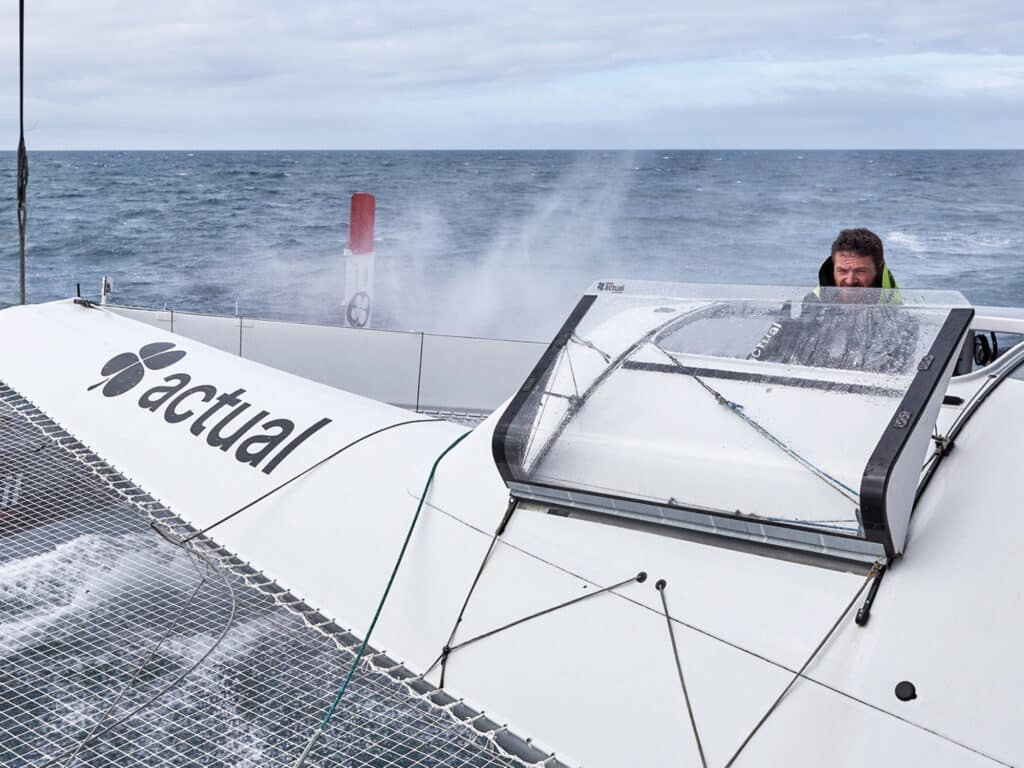
The Ultims are potentially so fast that their routing team can go a long way in ensuring that they stay in optimal conditions. For example, in the Southern Ocean, if they can get into the optimal reaching conditions in flat water ahead of a front, they can potentially ride this for days. But the biggest limitation is the solo skipper. The Ultims typically carry a mainsail and four headsails, including two gennakers and a permanently hoisted J2, all set on furlers. Tacking and jibing requires the sails to be released and sheeted in, the mast to be canted and tacked, and foils and rudders to be raised and lowered. It’s a process that typically takes 20 to 30 minutes. Le Cleac’h says that the most time-consuming sail change is going from the J0 to the J1 because the sails are heavy (around 120 kg), and this can take up to an hour. Factoring all this into the routing is vital because the skipper on his own can do only so much.
“If reaching 95 percent of the boat’s potential requires making three jibes and four tacks and to change two sails, it will be difficult to do that if you are tired,” Le Cleac’h says. His routers offer him three options—from the one offering optimal performance to the easiest for him to achieve—which can be decided based on his energy level and capabilities.
One positive for the skippers is that the required endurance is comparably short compared with a Vendée Globe effort, but still, so much remains unknown as they embark on this extreme test of man and machine.
“It is a bit like the first Vendée Globe,” Caudrelier says. “It is not quite the same because we know where we are going, but it is the first one, so it is a bit of an adventure. Usually you push to the maximum constantly, but for me, this is the first time I can’t do that. We will have to find the good balance between good performance and safety of the boat. That is an interesting exercise.”
- More: Arkea Ultim Challenge Brest , Print January 2024 , Racing , Sailboat Racing
- More Racing

Rivals Flush American Magic Facemask Rule Enquiry

The Reemergence of Jimmy Spithill

Running Tide Runs Swiftly Still

Mistakes And Misfires On the Final Day of Cup’s Preliminary Regatta

Emirates Team New Zealand Remain the Bullies of Barcelona

Start-Box Sparring in Barcelona on Day 2 of Preliminary Regatta

Real-time Wind Overlay Feature Added to Cup Broadcast

- Digital Edition
- Customer Service
- Privacy Policy
- Terms of Use
- Cruising World
- Sailing World
- Salt Water Sportsman
- Sport Fishing
- Wakeboarding
- Yachting World
- Digital Edition

The ultimate foiling machine? Onboard SVR-Lazartigue
- December 15, 2021
SVR-Lazartigue is the newest Ultim trimaran, designed for current solo around the world record holder François Gabart. Gabart gave François Tregouet an exclusive tour of this extraordinary machine.
Launched in July after 150,000 hours of work, SVR-Lazartigue is the latest addition to the burgeoning Ultim 32/23 fleet. In addition to the complexity that’s inherent to these giant foilers , this rocketship design includes many unique innovations which are currently being extensively tested and fine-tuned. We were lucky enough to be able to explore some of them in detail with skipper François Gabart.
Having boarded the team’s support RIB as they headed out from the MerConcept pontoon at around croissant-time, we searched for the blue giant among the squalls. François Gabart and Tom Laperche, who was co-skipper in this autumn’s Transat Jacques Vabre , were returning to their base in Concarneau, Brittany, having just completed a 1,000-mile training loop in the company of three other Ultims: Sodebo , Banque Populaire and Gitana .
SVR-Lazartigue finally appeared as just a dot on the horizon. There was no need to throttle up to reach it though: it was closing in fast. When it drew level, even with one reef in the main and no headsail, our big outboard-powered RIB was struggling to keep up. The crew heading out on deck to lower the sails appear tiny, whereas in reality Tom Laperche must be over 6ft tall.

Twin cockpit bubbles adjacent to the mast
While the overall dimensions of SVR-Lazartigue are as breathtaking as the rest of the Ultim class trimarans , certain proportions of SVR-Lazartigue immediately stand out. First, the floats seem particularly narrow. There are two reasons for this: as the helm stations are no longer ‘on’ the deck but integrated into the central hull, the latter seems proportionally beefed-up, especially between the two connecting beams.
The other factor is that as the latest generation trimarans spend more time in foiling mode, so the volume of the floats is no longer as critical.
Article continues below…
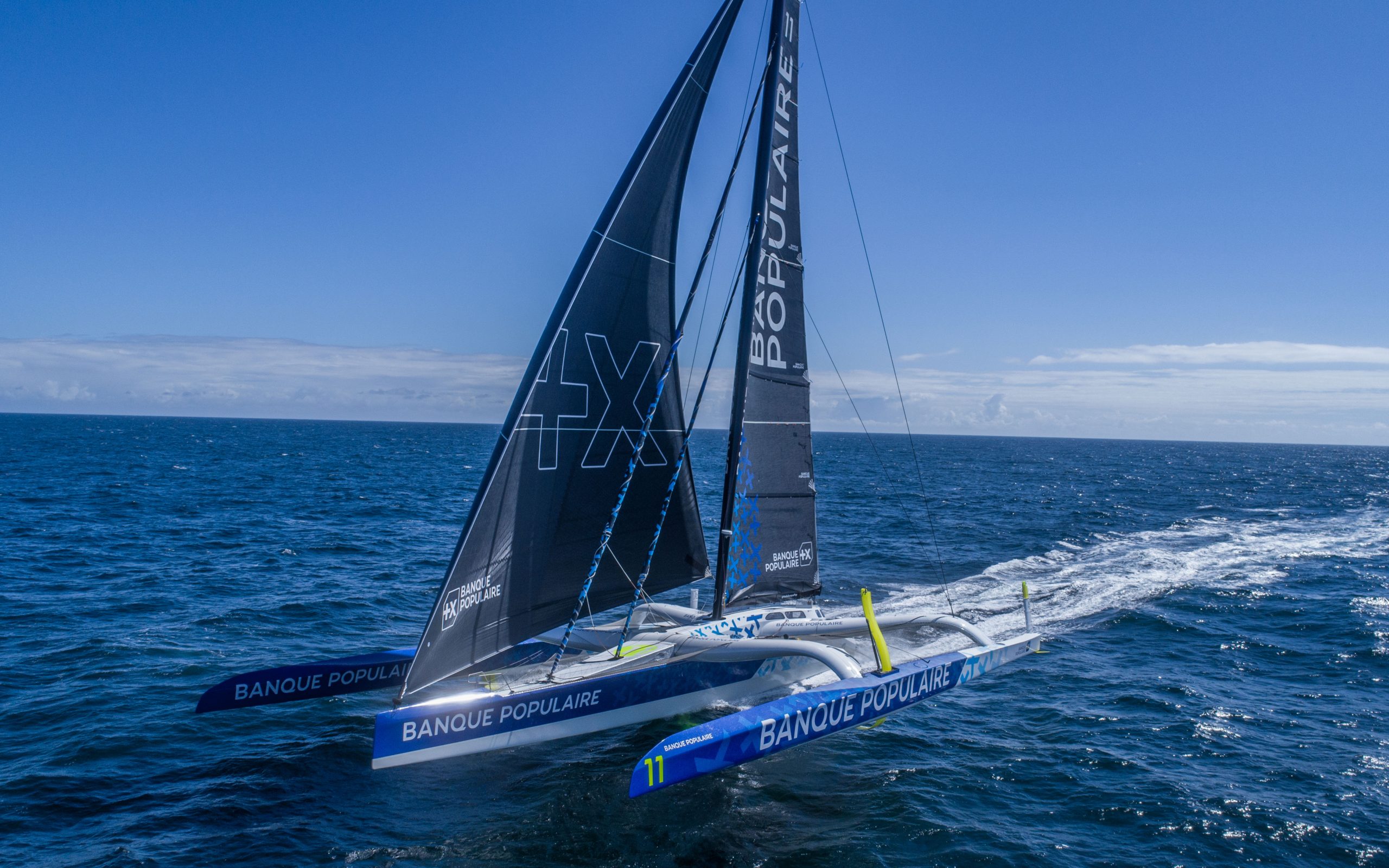
Extraordinary boats: Banque Populaire XI
Banque Populaire is one of the world’s most experienced and successful sailing teams, and was the force behind Armel Le…

Trying to break the 40-day barrier: Thomas Coville and the most radical Ultime yet
This week solo yachtsman Thomas Coville opened the doors to the build of his Sodebo Ultim 3, the newest Ultime…
The third dimension that stands out when viewing this monster vessel from the water is the length of the horizontal surface of the foil tip – it’s a full 4m (13ft) stretched under the net towards the central hull.
Onboard SVR-Lazartigue
Gabart is at the helm in the starboard cockpit. This is the trademark of his new baby: two sliding bubbles, flush with the deck, which call to mind a Spitfire aeroplane or fighter jet. The analogy is not accidental: these ultra high performance trimarans reach such high speeds that staying outside is not only uncomfortable, but almost unbearable, and certainly incompatible with achieving a high level of human performance.

Boat speeds of 40 knots have become the norm – below 30 knots the crew feels unusually slow!
Despite being exhausted, Gabart and his teammate are smiling broadly. They have just completed a 200-mile reaching leg at an average boat speed of 37 knots, racing side by side with Sodebo. But to have completed 1,000 miles in racing conditions without any major technical problems in such a new launch is clearly the main satisfaction. That’s a triumph for Gabart’s MerConcept technical team – just a week before, they had to abandon the Défi Azimut Ultim race following damage to a foil jack.
Hydraulics are a key component on these boats. With enormous forces involved there are 23 hydraulic cylinders onboard on SVR-Lazartigue. One of the particularities of the Ultim class is that everything on board must be controlled by human power; only so-called closed-loop circuits are allowed.

Above: electronics, regulators, electric engine and a small diesel generator are housed under the floor of the cockpit and living areas
So while the grinders are connected to the winches, they are also connected to hydraulic pumps. If, for example, the crew want to increase the rake on a foil by 3°, they set the control to 3°, open the valve and it goes up to 3°. But the hydraulic pressure to achieve that has to be generated by the two-man crew, and it is in no way automated or self-adjusting.
65 knots of apparent wind
Most of the cylinders are hidden – inside the boom, behind a foil arm, and down below – the aerodynamics are optimised as never before on an offshore boat.
The apparent wind created by the speeds reached is “mind-blowing”, says Gabart. “This is the most impressive thing about this boat. We have never had these apparent wind figures on other boats.
“Here, we regularly reach speeds of over 40 knots at less than 90° true wind angle (TWA). In certain conditions, such as 25 knots of wind on flat seas, at 65°-70° off the wind, you’re doing 40 knots. That’s 60-65 knots of apparent wind speed. The maximum AWS in our log is not far from 70 knots.

The low profile fighter pilot-style cockpit ‘pods’
“When you go outside, it’s violent. Compared to the previous generation, this is where the difference is the most significant, between 65° and 80° off the wind, where we see very strong apparent winds,” Gabart explains.
At these speeds air resistance takes on an unprecedented importance. The design team, including VPLP , has focussed heavily on creating an aerodynamically optimised shape with every element refined to offer the lowest possible drag. The upper part of the foredeck is non-structural – all the strength is underneath at the level of the anchoring points of the headsails.
“The interesting [point] is that we can stow the sails there, protected from the wind. In the long term it will be closed off by a canvas cover to reduce water ingress, even though there are drains on the sides. This is an area that still needs to be optimised. We can see that the technical team seems to have played with the jigsaw before this training session,” observes Gabart.
Fred Bérat, the boat captain, asks Tom Laperche for his feedback. “We’ll have to use foam or partition off the unused areas to reduce the volume likely to take on sea water,” Laperche comments. That will add weight, but aerodynamically, nothing protrudes, the furling drums are completely hidden and the sail is flush with the deck when unfurled.

Gabart, a passionate engineer, explaining how the foils work. Each weighs 400kg (882lb) and supports a trimaran that weighs 38 times that
The entire deck and structure is designed to favour laminar flow and reduce air disturbance. All the way aft, only the two small cockpit bubbles protrude from the deck. Even the Fleet communication antennas, although cylindrical, are streamlined at the rear.
Within each of the two cockpit bubbles, a small Formula 1-type steering wheel acts as a helm. For the time being, only one button is fitted, the emergency mainsail release button, but more controls will come in the long term, Gabart explains. “We imagine we’ll be able to put a lot of things on it, especially for safety. And possibly sail adjustments when there are people around to grind the winches and therefore power the hydraulics below deck.”
The pilot-style flight position is designed to help the sailors maintain focus and high levels of performance while helming for long periods of time.“While we thought we would have to wear a helmet or harness to avoid hitting our heads, it turns out we are very well supported at shoulder level, especially since we don’t have to steer at high angles. You can steer standing up or sitting down and footrests are due to be fitted soon.”
Gabart is confident he’ll be able to spend hours comfortably at the helm “just like in a car”.
Fingertip conrol on SVR-Lazartigue
Three rudders are mechanically connected at the back of the stern arm, while at the front, electronics are used. The two Madintech pilots have their cylinders permanently connected to the same central rudder shaft.

More fingertip controls are planned for the Formula 1-style steering wheel in future
Just above, on the outside, a conventional wheel is connected directly to it, which is more practical for port manoeuvres or race starts: “Because we can see what’s going on better and we’re more used to the feeling. In the long term I am confident that we will be able to have the same feeling and efficiency on our small steering wheels, from a distance, but there is still work to be done, especially because of the speed of reaction of the cylinders,” he says.
From the inside helm stations or watch stations, as well as the companionway access just aft, there’s good visibility, almost 360°, even under the boom. However, below deck, where manoeuvres, navigation and living space are organised, there is no direct view outside.
As on Alex Thomson ’s IMOCA Hugo Boss , cameras have been installed for an exterior view. But the two SVR-Lazartigue co-skippers admit they’re not yet always in the habit of automatically looking at the screens.

Chainplates and furling drums for the headsails are integrated under a false deck to help aerodynamics
At the stern, all sheets are tunnelled to two huge 43cm diameter Harken Air 900 winches: “We can put each of the eight sheets, which all arrive at the same place, crosswise on the two main winches, so we can do peels at any time between any sails: J0, J1, J2 and J3,” says Gabart. Up front are the so-called utility winches for halyards, furling lines, reefing lines, or barber-haulers.
Living zone
At the rear of the low-slung, white painted cockpit, a living area houses a navigation zone with a newly installed bucket seat facing a canting screen. There is a beanbag for sleeping on the floor, although berths will be installed on both sides for stowage. The only extra is a micro-galley.
Forward is another living area, this one in bare carbon, located along the centre of gravity of the boat. When the boat is being sailed in crewed mode, the space is big enough to sleep six people in a race or on a record attempt. “In terms of noise, we were quite uncertain about this central hull living area,” admits Gabart,

As well as nav and performance information the screens also display the positions and trim settings of the foils, rudders and centreboard
“I’m surprised, because intuitively I thought it would be quite different from the previous boat (Macif which became Actual) and in the end, here, in the closed cockpit, it’s quite similar. As soon as you put your head in the bubble, even when it’s closed, you hear and feel the wind, just like before.”
The central hull on SVR-Lazartigue is divided in two along its entire length, with a lower level under the cockpit and the living areas. In addition to the electric motor, the battery pack and a small diesel generator, there are a lot of electronics housed below. “Emilien Lavigne, the computer and electronics specialist is, after me, the one who has sailed the boat the most since she was launched,” points out the skipper, such is the importance of the hidden technology on board.
Meanwhile the most obvious examples of latest development technology are the incredible wings of this boat designed for flight. The shape of the SVR-Lazartigue foils is particularly complex, between the L-shaped lower section and and the S-shaped vertical a free ball joint gives a degree of freedom in the foil boxes to be able to raise and lower them. The upper section moves longitudinally, allowing the rake to be adjusted.

Skipper for scale! The two main Harken Air 900 winches on which all the headsail sheets are mounted
Unlike a conventional racing yacht, the VPPs (velocity prediction programmes) provided by the architects VPLP are much more than simple polars with the speed targets. The charts, displayed in the cockpit, also recommend theoretical settings for foil depth, rake and flaps.
“It’s amazing how good the fit is, on a windy sea, in out-of-the-ordinary conditions like a reaching leg in 40 knots, 50m from the beach without a single wave. Or the opposite, like now, where there’s only 10 knots of wind, but the sea remains rough following the passage of a front,” says Gabart.
As for the sensation of foiling at high speeds, Gabart is effusive about the behaviour of his blue rocket: “The more foil surface you have, the more damping there is in the waves. When you fly, there are few shocks, just quite violent movements due to the high speed. When the boat jumps a wave, the foil never really comes out of the water, even if it stalls, it absorbs a lot. Even when you’re not flying, at the same speed, it’s much more comfortable than an IMOCA. Even though, sometimes we go twice as fast…”
SVR-Lazartigue specifications
Length: 32m / 105ft 0in Beam: 23m / 75ft 5in Displacement (approx): 15,000kg / 33,000lb Weight of one foil: 400kg / 880lb Draught: 4.5m / 14ft 9in Air draught: 37m / 121ft 5in Mast length: 33m / 108ft 3in Sail area upwind: 425m² / 4,574ft Sail area downwind: 645m² / 6,942ft
If you enjoyed this….
Yachting World is the world’s leading magazine for bluewater cruisers and offshore sailors. Every month we have inspirational adventures and practical features to help you realise your sailing dreams. Build your knowledge with a subscription delivered to your door. See our latest offers and save at least 30% off the cover price.
BoatNews.com
François Gabart and his crew aim for the Jules Verne Trophy record in 2024
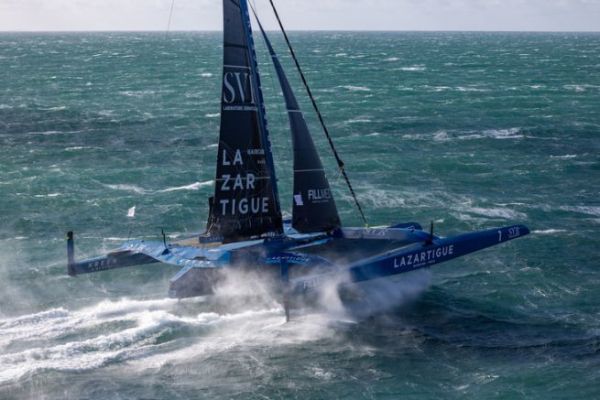
Tom Laperche: 1st skipper forced to retire from the Arkea Ultim Challenge
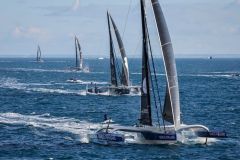
Arkéa Ultim Challenge: what authorizations and prohibitions apply during a technical stopover?
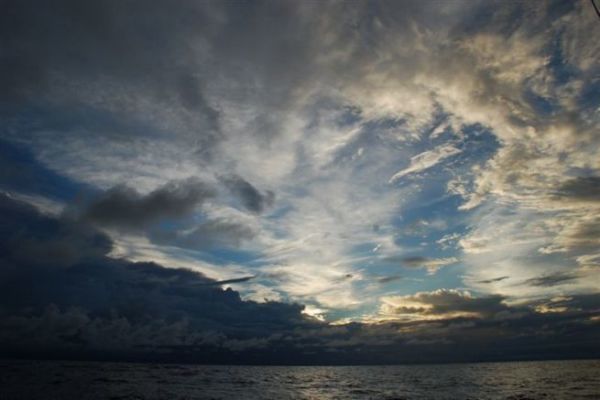
The Ultims arrive in the Doldrums, what's that?

Ocean racing diary: Arkéa Ultim Challenge, Rorc , Sidney Hobart, GSC, SailGP
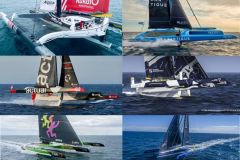
Which giant trimarans will be lining up at the start of the Arkea Ultim Challenge?
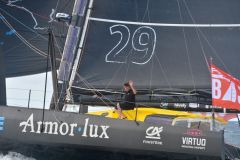
Ocean racing logbook: Ocean Globe Race, Gitana Team, Retour à la Base...
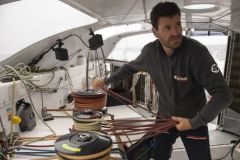
Anthony Marchand: "We're adjusting the cursor between upgrading and making our Ultim more reliable"
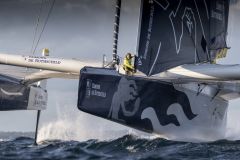
Gitana 18, a new Ultim designed for long crossings and speed, announced for 2025

Transat Jacques Vabre: Weather disrupts schedule with scattered start
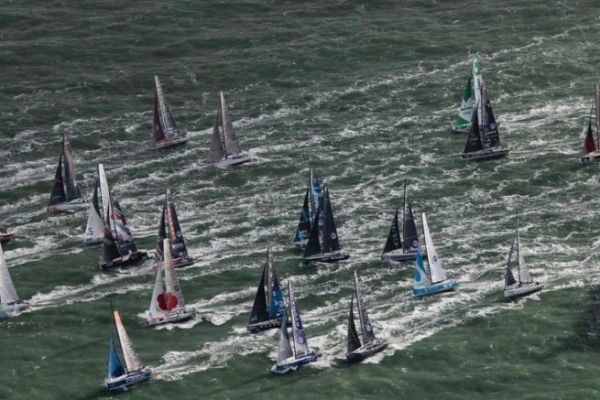
History of the Transat Jacques Vabre from 2017 to 2021: records of all kinds!
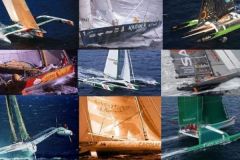
What happened to the yachts that won the Transat Jacques Vabre?
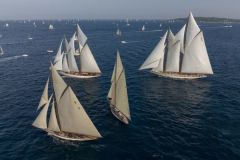
Ocean racing logbook: Voiles de Saint-Tropez, Transat Jacques Vabre, 24H Ultim...
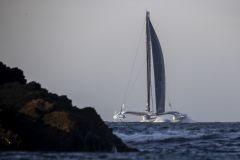
24H Ultim: small gaps between the Ultim trimarans on the eve of the Transat Jacques Vabre
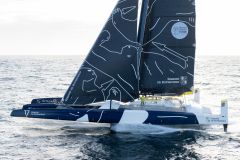
Ocean racing logbook: Voiles de Saint-Tropez, 24H Ultim, IMOCA, Mini Transat
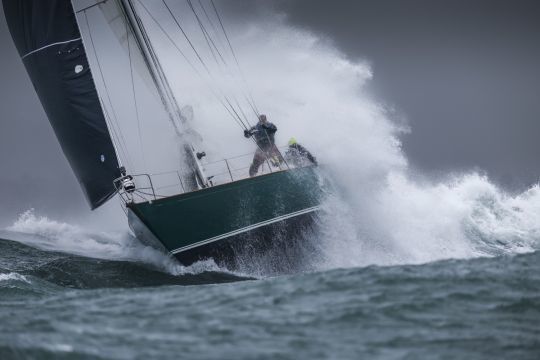
Rolex Fastnet Race, relive the 2023 edition marked by exceptional participation
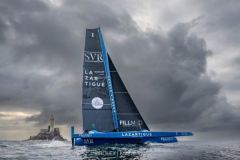
Ocean racing diary: Rolex Fastnet, IMOCA, Solo Guy Cotten and record attempts
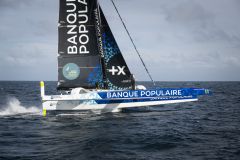
Arkea Ultim Challenge, the line-up for the first round-the-world Ultims race unveiled
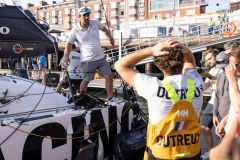
Journal of ocean racing: Jules Verne, Ocean Race, Golden Globe Race, Windsurfing and Solitaire
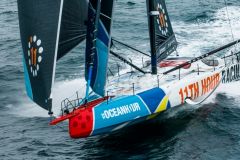

Journal of ocean racing: 470, IRC, ProSailing Tour, The Ocean Race, Tour Voile and Ultim
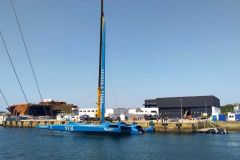
Trimaran SVR - Lazartigue: The 1st images of the modified trimaran

SVR-Lazartigue and Ultim Class 32/23 conflict, the way out finally found

Arkea Ultim Challenge, the round-the-world Ultim race unveiled
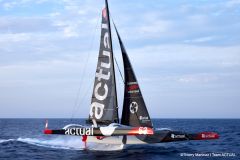
A new skipper and a new manager for Actual Ultim 3

Arkea Ultim Challenge, the Ultim Round the World Tour, is taking place!
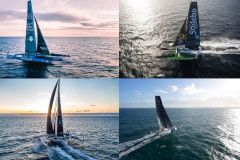
Ultim class, what are the teams' programs for the winter of 2022?
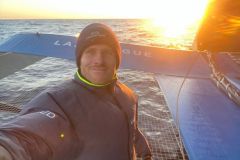
Route du Rhum 2022: between dismastings and capsizings, finding your way around the start of the race
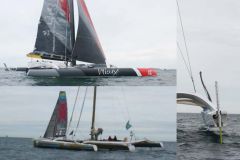
When the floats of multihulls tell their story
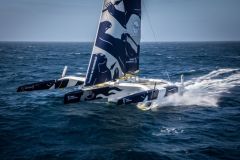
Ultim class, towards a new race time on the Route du Rhum?
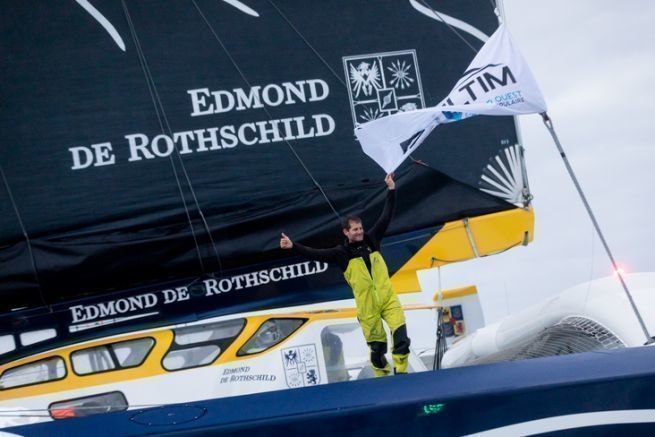
Caudrelier: "What scares me is the collision with another boat"

Route du Rhum 2022, an update on the entries in each class

The profession of median explained by Ronan Gladu
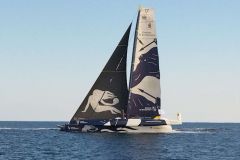
Ultim, the last race before the Route du Rhum 2022 reopens the game?
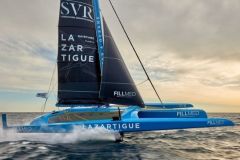
Detailed visit of the trimaran SVR Lazartigue, before the 1st record of the Ultim
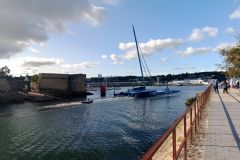
Finistere Atlantique: "A taste of the Route du Rhum for the Ultim trimarans
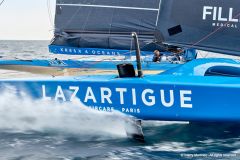
New stage in the incomprehensible war between the Ultims
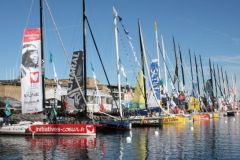
Route du Rhum 2022 : The last sailors registered for the Transat unveiled
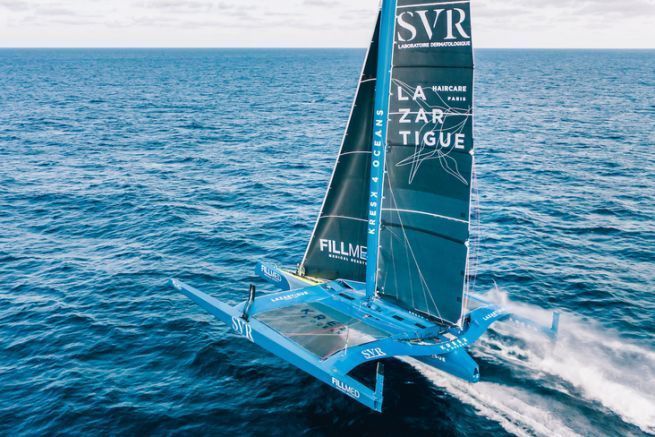
SVR-Lazartigue trimaran non-conformity, different points of view in Ultim class

Multihull winners of the Jacques Vabre: Favorites and outsiders on the podium
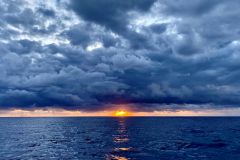
A slow-moving fleet in the 2021 Transat Jacques Vabre
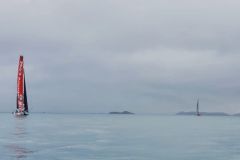
An air of Doldrums with a Breton twist hangs over the Jacques Vabre 2021

Mise à l'eau à Lorient et Concarneau ce lundi Photo : Gwen_29Sud

Deuxième édition au départ de Concarneau, pour les cinq Ultim'

les chantiers des chantiers à Lorient
Ultim Evènements à venir
5 septembre 2024 24 H Ultim'
25/09 au 06/10/24 Finistère Atlantique Concarneau/Antibes
19 octobre 2024 Rolex Middle Sea Race
Tentatives sur le Trophée Jules Verne
Mai 2025 Med Ultim
Juillet 2025 Rolex Fastnet Race
Septembre 2025 24 h Ultim
Octobre 2025 Tour du Monde à l'envers
Octobre 2025 Trophée Jules Verne
Novembre 2025 Transat Jacques Vabre
Juillet 2026 Finistère Atlantique
Septembre 2026 24h Ultim
Novembre 2026 Route du Rhum
Juin 2027 Lorient / Les Bermudes / Lorient
Juillet 2027 Rolex Fastnet Race
Septembre 2027 24 h Ultim
Novembre 2027 Transat Jacques Vabr e

Ultim Championnat 2024
1 Maxi Edmond de Rothschild 20
2 Sodebo Ultim' 3 19
3 Banque Populaire XI 18
4 Actual Ultim' 3 17
5 ADAGIO 16
6 Argo 9
7 Zoulou 7
8 Limosa 5
Classement 2019
Classement 2018
Classement 2017
Classement 2016
Classement 2015
Franck Cammas
Tom Laperche
François Gabart
Francis Joyon
Yves Le Blévec
Anthony Marchand
Sam Goodchild
Eric Péron
Thomas Coville
Gwénolé Gahinet
Jean Luc Nélias
Armel Le Cléac'h
Sébastien Josse
Charles Caudrelier
Romain Pilliard
Archives Ultimes News années 2020 à 2022
Archives Ultimes News années 2016 à 2019
Archives Ultimes News années 2014 à 2015

Ultimes évènements passés
Route du Rhum 2014
Jacques Vabre 2015
The Transat 2016
The Bridge 2017
Jacques Vabre 2017
Nice UltiMed 2018
Route du Rhum 2018
Brest Atlantiques 2019
Jacques Vabre 2021
Finistère Atlantique 2022
Route du Rhum 2022
Jacques Vabre 2023
ARKEA Ultim' Challenge Brest :
Préparation d'avant course
La descente de l'Atlantique Nord
La descente de l'Atlantique Sud
L'océan Indien
Le Pacifique
La remontée de l'Atlantique Sud
La remontée de l'Atlantique Nord
Record de Thomas Coville sur Sodebo Ultim'
Record de François Gabart sur Macif
Trophée Jules Verne 2015-2016
Tentative 2017 Spindrit 2
Tentative d'IDEC Sport
Tentative Spindift 2 2019
Tentative Gitana 17 2020
Tentative Sodebo Ultim' 5 2020
Tentative Sails of Change 2021
Tentative Gitana 17 2023
ITW Sam Goodchild
De Formule TAG à Energy Observer
Macif la construction
Trophée Jules Verne Spindrift 2 2019
Tour du Monde à l'envers 2017 Actual Ultim'
IDEC Asian Tour
Tour du Monde à l'envers Use it Again
Yachting Monthly
- Digital edition

Wow, that was fast! Why trimarans are SO much fun to sail – and how to do it
- Theo Stocker
- February 13, 2024
For their size, trimarans can punch well above their weight in speed, cruising potential and fun. Monohull sailor Theo Stocker gets to grips with how to handle one
Humans tend to gravitate into tribes of like-minded enthusiasts, enjoying the encouragement, support and sense of identity, while often looking askance at others; sailors at motorboaters, cruising sailors at racers, monohull sailors at raft, I mean, multihull sailors, and everyone looks askance at jet-skiers.
Large cruising catamarans (40ft now counts as a small one) are a world apart from monohull sailing, but there’s a sub-tribe of sailors dedicated to life on three hulls and builders such as Dragonfly, Corsair, Farrier, and Astus give them plenty of choice.
I’ve been sailing a 22ft (7m) Astus 22.5 this season, with just enough space for a family of four and a minimum of creature comforts. Thanks to her VPLP-designed hulls and 650kg all-up weight, we can sail upwind at 7-plus knots and downwind at over 10 knots with ease, all on a roughly even keel, while the kids play Duplo down below. It can also be beached and is towable behind a car.
Having, it seems, caught the trimaran bug, I wanted to get better at sailing and handling the boat, but my monohull sailing experience and habits were proving something of a hindrance, so we sought advice from some existing trimaran owners, and well as the UK’s top multihull sailors.
Much of the advice will apply to all multihulls , whether two or three-hulled, while other parts are just for small trimarans. I also found that brushing-up some of my rusty dinghy sailing skills helped get my head around what we were trying to do.
To try out our expert tips we went out sailing to see what difference they made. On the day, we got a solid Force 4-5 southwesterly, averaging 16 knots, but fluctuating between 12 and 20 knots true.
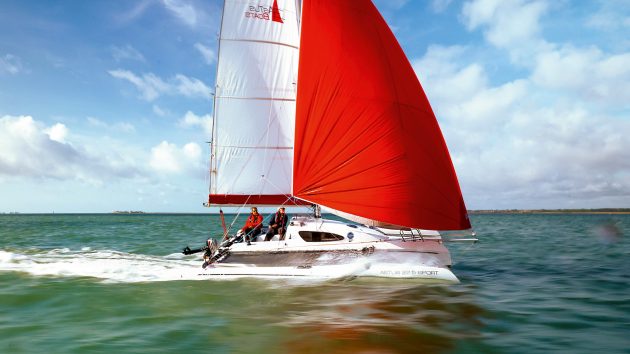
Blasting about on a sporty trimaran is a whole world of fun, but is much calmer than it looks
Trimaran sail trim
One of the biggest differences between a cruising monohull and a multihull is how the mainsail is trimmed. Leech tension on a yacht is often largely controlled by the kicker and the backstay, while the mainsheet sheets the mainsail in and out, predominantly controlling the angle of the boom to the centreline, and there may be a short traveller.
On a mulithull, however, there’s more than enough space for a good, wide traveller. Those who sail on performance monohulls will also be used to this. The sail shape is mainly controlled by the mainsheet, and the traveller then moves the boom towards or away from the centreline.
This is exaggerated on a multihull which has wide shrouds, swept well aft with no backstay, making space for a powerful square-top mainsail with full-length battens. There’s no backstay to bend the mast and flatten what is anyway a pretty rigid mainsail.
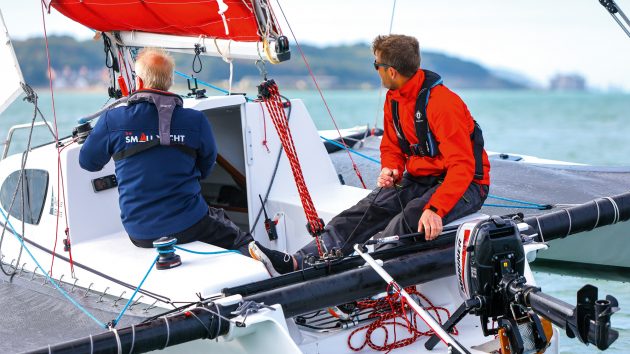
The mainsheet purchase creates enough power to control the leech of the square-top mainsail
Depowering a trimaran
Sailing on a monohull, heel and weatherhelm and eventually a broach give loads of warning that you’re pushing too hard. With straight hulls and little heel, those warning signs don’t really apply to multihulls.
In reality, however, there are a host of warning signals that it’s time to back-off; they’re just a bit different. Even then, there’s still a large safety margin before you get close to danger.
By way of reassurance, with the boat powered up on a beat, Hein, from Boats on Wheels, the boat’s owner, stood on the leeward hull and lent on the shrouds. Even as his feet got wet and the wind gusted at the top of Force 4, the boat didn’t bat an eyelid, thanks to the huge buoyancy of the floats.
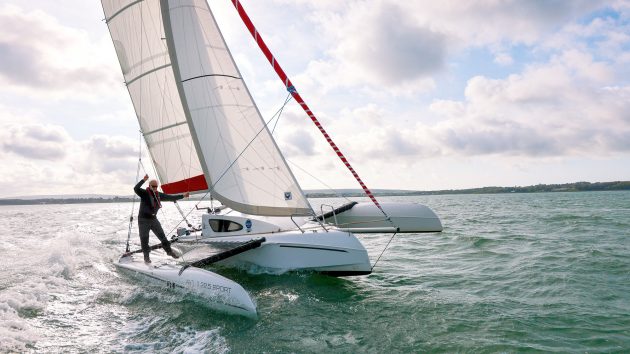
Even with a person on the leeward float the boat was extremely stable
On the water – sail trim
My first inclination was to point the boat as high upwind as possible, pin the sails in and go for height. Doing that resulted in a not-terrible boat speed of 5-6 knots and a good pointing angle.
Free off by a handful of degrees however, and ease the sails just a smidge, and the speed leapt up to 8-9 knots – over 50% more; a huge increase. So, don’t pinch. If you had a decent chartplotter on board, you could find your optimum speed to angle using velocity made good (VMG).
I was also tempted to pinch in the gusts, but it’s better to hold your course and let the speed increase until the main needs easing.
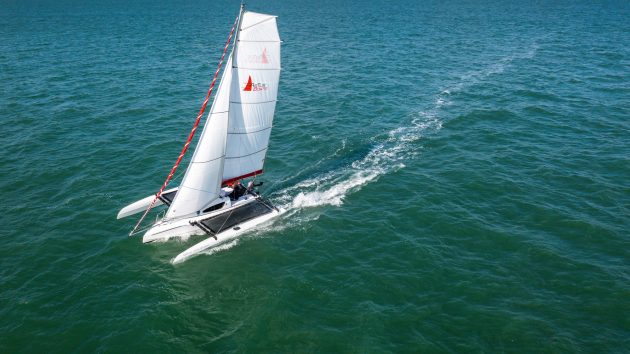
On the wind, it’s time to get the boat fully powered up
If that’s the case, drop the main down the traveller an inch or two or ease some twist into the mainsail and it makes all the difference in the world, but not so far that the top battens fall away and invert – that really isn’t fast. Push too hard and the boat will slow down, largely from the drag of submerging the leeward float and crossbeams. If you’re still overpowered and the main is luffing, it’s time to reef. Downwind is different, but we’ll get onto that later.
After we put a reef in the main, our boat speeds upwind remained largely the same, and the boat was much happier. I came away feeling reassured that even a little trimaran like this would be pretty difficult to capsize, and there were always plenty of warning signs telling me to take my foot off the pedal a little.
Article continues below…

Catamaran sailing skills: Mooring and anchoring a multihull
How do you make an average passage speed of 7 knots, fit in three double cabins and a huge saloon…

Monohull or multihull: which is best for blue water?
As former editor of Yachting World, David Glenn has plenty of experience of both monohull and multihull cruising. Here he…
Tacking and gybing a trimaran
Everyone knows that multihulls don’t tack as well as monohulls. Straight hulls and wide beam don’t lend themselves to turning, especially when coupled with the displacement and fixed keels of big cats. Trimarans are a little easier, with a single central daggerboard to act as a pivot, and one or other of the floats will generally be clear of the water. On the downside, light displacement means that there isn’t much momentum to keep you going through the turn and plenty of windage to stop you.
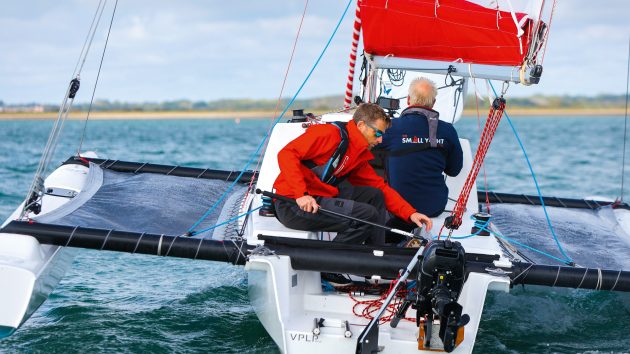
On a trimaran the central daggerboard helps the boat to turn by providing a central pivot point that catamarans lack
Speed is your friend. Build speed up before the tack to give you as much momentum as possible. The helm needs to steer positively into and through the turn, and if necessary, keep the jib backed on the new windward side to help the bow through the wind. Don’t worry about scrubbing speed off, but you don’t want to get stuck in irons.
When it comes to gybing, speed is again key. The turning bit isn’t going to be an issue as you’ll be scooting along, but the faster you’re going, the less load there will be on the sails. The more you slow down, the more the true wind will pile up.
Trimaran sailing skills
Tacks took a bit of practice. It felt plain wrong to jab the tiller across the boat, slamming a big break on in the water but I ended up putting us through the tacks far too slowly, losing a lot of speed. A more aggressive approach worked better. On the Astus, the traveller was between me and the tiller, so the tiller extension needed to be swung around the stern behind the mainsheet onto the new side.
Similarly, old habits of controlling a gybe needed to be modified. With the asymmetric set, we were planing at well over 10 knots, and the ideal is to stay on the plane. Heading dead downwind and centring the main lead to a more violent manoeuvre than flying into the gybe as fast as possible and, as the boom was never that far out thanks to the apparent wind angle, it didn’t need much extra controlling.
Coming up onto the wind after the gybe helped the asymmetric around the front of the jib and to fill on the new side. Stay too deep and it’ll get blanketed by the main. Once we had built up some apparent wind, we could bear away again.
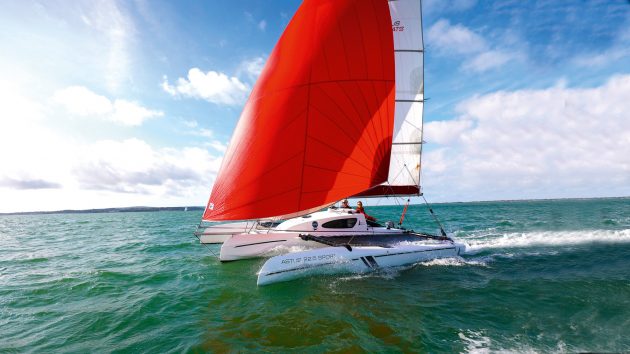
You’ll be on a course deep downwind before you know it, hitting speeds in the double digits
Downwind in a trimaran
Upwind cruising may be fun in a multihull, but bearing away and going with the wind is what it’s all about. Easily-driven hulls, a generous sailplan and light weight mean you can be up and planing, leaving displacement boats wallowing in your wake.
The big difference comes from apparent wind. If you’re in a boat that can do 15 knots downwind in 20 knots of true wind, the resulting wind angles can really mess with your head.
To get going then, says Brian Thompson, ‘Use those leech tell-tales again when sailing downwind and reaching to set the correct twist through the mainsheet, and use the traveller to set the correct angle of the whole sail to the wind.’
As the wind and your speed builds, bear away and trim the main accordingly.
In theory, you shouldn’t need to ease the traveller at all, but you may need to if you want to sail deep downwind. As the gust fades, you’ll find the boat slows down, so you can come back up towards the wind a little to pick up some more breeze, and then bear away as you accelerate again.

Bear away as the boat accelerates. Your course will be something of a slalom as you look to keep a consistent wind angle
This results in something of a ‘slalom’ course, and will also be accentuated if you’re sailing down waves, but that’s all quite normal for apparent wind sailing. Ultimately, you’re looking for a consistent apparent wind angle, even if the resulting wake isn’t straight.
It’s worth remembering that apparent wind reduces the felt effect of the wind, so you need a sailplan to suit the true, not apparent wind speed.
I found that the boat was more sensitive to having a balanced sailplan and trim downwind than upwind, largely because you’ve got almost double the canvas up, with the bowsprit as an extra lever. When weather helm built, I needed to ease the mainsheet to increase twist to depower so that I could bear away. I must admit, getting the boat balanced, sailing fast and light on the helm at 15 knots was something I came away feeling I needed more practice at.
Reviewing the images, I suspect the asymmetric was sheeted in too hard, with too much twist in the main.
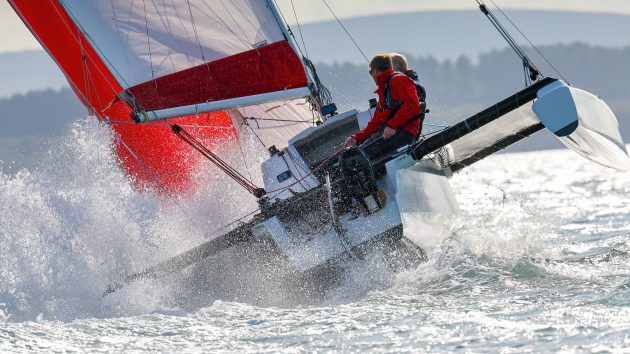
Getting a float fully submerged is when it’s time to back off
On the water
Unfurling the gennaker worked best on a beam reach, giving plenty of airflow over the sail to help it fully unfurl. This was also roughly the fastest point of sail, ideal for getting up some speed for apparent wind sailing. We mostly had the sails set for a close reach, even when we were beyond 120º off the true wind on a broad reach.
It was possible to soak deeper downwind, but lose the apparent wind benefit downwind and our speed dropped off dramatically, prompting us to point a bit higher to find some more speed.
As the boat powered up, it paid to hold a slightly higher angle than I would have done in a monohull for the boat to properly take off and get up into double digit speeds – topping out at 15 knots. Lymington to Cowes would have taken us just half an hour at that speed. It’s easy to give yourself a heck of a beat back!
We were sailing on a pretty flat day, so didn’t have to contend with any waves to speak of. On the recent RTI this is what caused the capsizes of at least two multis, a sobering reminder that you need to sail much more conservatively in lumpier conditions.
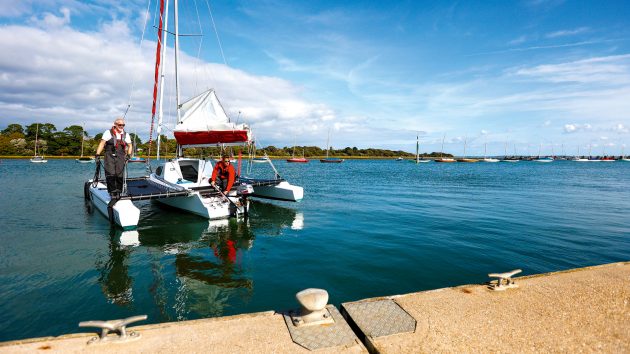
The bows want to point downwind, so a stern-first approach works with rather than against the boat
Coming alongside
A 650kg boat with no draught and plenty of windage feels dreadfully skittish when manoeuvring in confined spaces. Straight hulls with no forgiving curves and fragile-looking sharp bows make berthing tricky. You’ve got a couple of advantages on your side, however. In the Astus, the floats are at pontoon height making stepping off easy.
Whether you have an engine in each hull of a cat, or one in the central hull of a tri, there’s also a lot more leverage to play with to turn the boat and drive her on or off the pontoon. A steerable outboard gives you even more options.
If the boat has a lifting keel or daggerboards, put them down if there’s enough depth to give you a pivot and to resist drifting. Think about getting corners onto the pontoon, rather than putting the boat alongside. On tris, you won’t be able to get to the bow to fend off as it’s too narrow. You can rig a fender up forwards on a line, and two fenders are enough on the flat sides.
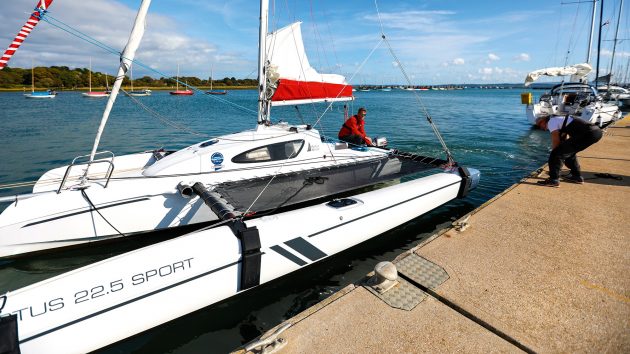
Steering with the outboard towards the pontoon will drive the stern in more; steer away to drive the bow in more
Offshore wind
Coming onto the pontoon with wind blowing off, it worked well coming in stern first. If there’s a tide running, you’ll want to be heading into the tide, so find a spot down wind and down tide to start your approach so you come in at an angle.
On our first attempt we had a bit of tide under us to start with so we came in at a much steeper angle, almost 90º, although this worked out OK in the end.
The crew could then step ashore, taking a line from the stern quarter round a cleat.
Drive forwards against the line and the bow will obediently drive up towards the pontoon, bringing you flat alongside. Getting off was simple, releasing the bowline, and allowing the bow to swing out the before slipping the stern line.
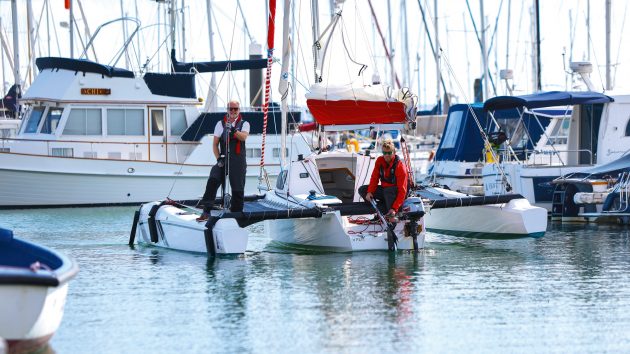
Coming in astern and stopping upwind of the berth meant the bows blew towards the pontoon far to quickly
Onshore wind
Getting onto and off a pontoon with onshore wind proved rather trickier. On our first attempt we came in stern first. The issue was that once we were just upwind of our desired berth and stopped, we lost steerage and the bow immediately blew off with alarming speed towards the pontoon.
Going ahead would only increase the force of the impact, while going astern only increased the bow’s sideways drift. I managed to back out without smashing the bow, but only just, and ended up awkwardly stern to the wind with the bows pointing at the pontoon.
On our second attempt we came in bows first but having aimed at the berth, I had to motor the stern to leeward to stop the bow hitting, making for a rather forceful coming alongside.
On take three, I came in forwards and began ferry gliding towards the berth early, keeping the bows to windward of the stern. Being able to steer with the outboard meant I could go ahead to keep the bow up, and go astern with the engine pulling the stern down toward the pontoon. In this way, it was possible to come in pretty well controlled and parallel to the berth.
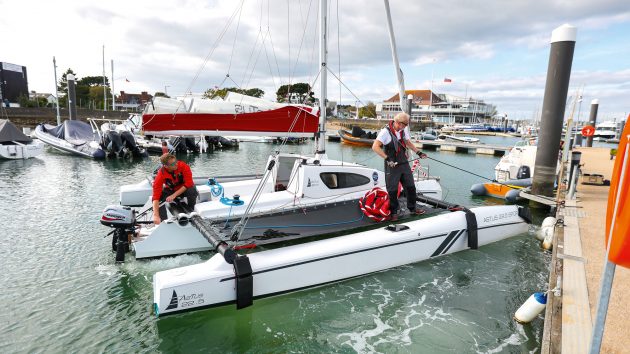
To get out, motoring astern against a bow line pulled the entire boat clear before slipping the line
Leaving was a different proposition all together, as I didn’t want to drag the bow along the pontoon, or to drive hard onto it to spring off. Instead, we rigged a slip-line from the forward cross beam. Going astern against this, and then turning the engine towards the wind, I could pull the stern, and the rest of the boat, out and away from the pontoon.
Keeping power on astern, once we’d reached a decent angle, we slipped the line and went astern, finding steerage way almost at once, with the bow following obediently in our wake with more control than I had anticipated.
Whether the wind is blowing onto, or off the pontoon, you want the engine to be driving or pulling the boat off the pontoon with a line on the corner you are going away from. That way you avoid point-loading fine ends where it’s hard to fender.
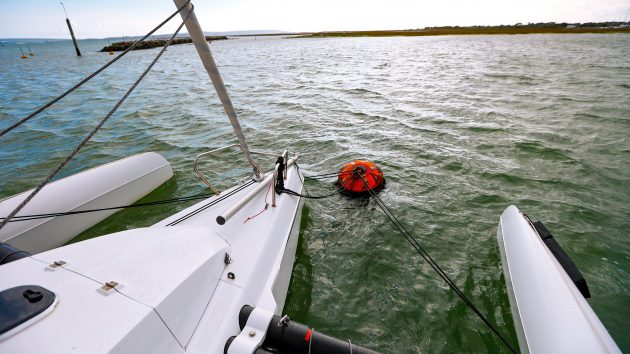
You’ll want a bridle to reduce swinging, but keep the pick up lines on the bow as backup
Anchoring and mooring a trimaran
While mooring a catamaran is complicated by the lack of a central bow, things should be simpler on a trimaran, and they are, mostly. Picking up a mooring buoy from the main hull bow with a low freeboard and dropping the pick-up line onto a cleat is easier even than a monohull.
The bow may be narrow, but for any lines that pass through a ring on the buoy, you still need to take it back to the same cleat to avoid chafe. That should be it, but windage from the two extra bows and the lack of keel mean the boat can dance merrily around the mooring buoy in a breeze.
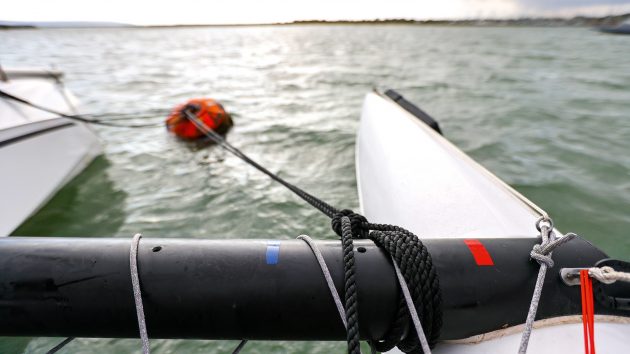
Rig the bridle so the buoy sits to one side to stabilise the boat
In practice, we found that a trimaran benefits from a mooring bridle in the same way that a catamaran does. It can’t be rigged from the floats’ bows, as there are no mooring cleats, so a line passed around the outboard ends of the forward beams gave a pretty good angle, again with long lines passed through the mooring and back to the same side. The main pick-up lines stay as a safety backup.
The other trick is to rig the bridle asymmetrically so that the buoy sits to one side or the other, just enough to not be dead head to wind, making it much more stable in the wind.
On the plus side, the lack of draught or keel means that you’ll nearly always be lying head to wind, so the cockpit remains nice and sheltered whatever the tide’s doing.
We ran out of time on the day to try anchoring, but rigging a bridle, effectively a long snubber to a point on the anchor chain in a similar way wouldn’t be tricky.
If you needed not to swing, or to behave more like deeper boats nearby, hanging a bucket over the stern can help, or there’s always anchoring with a kedge, either out ahead in a V, or in line astern.
Enjoyed reading this?
A subscription to Yachting Monthly magazine costs around 40% less than the cover price .
Print and digital editions are available through Magazines Direct – where you can also find the latest deals .
YM is packed with information to help you get the most from your time on the water.
- Take your seamanship to the next level with tips, advice and skills from our experts
- Impartial in-depth reviews of the latest yachts and equipment
- Cruising guides to help you reach those dream destinations
Follow us on Facebook , Twitter and Instagram.

IMAGES
COMMENTS
Le trimaran Actual 3 vu par la team. « Il fait partie des bateaux volants qui ont le plus navigué, c'est un excellent compromis de fiabilité/performance. Il a son âge, l'architecture navale progresse en permanence, mais on va jouer cette carte : garder ce super potentiel jusqu'à l'arrivée des courses. Ronan. « Il est complexe.
Anthony Marchand, 38, has also newly taken on a campaign, replacing Yves le Blevec on Actual Ultim 3 (ex-Macif) in early 2023. ... sucking the trimaran's main hull down. "If you release the ...
Tom Laperche (FRA) - Trimaran SVR-Lazartigue - 10.9nm behind - Speed: 29.9kts 4. Thomas Colville (FRA)- Sodebo Ultim 3 - 15.2nm behind ... Anthony Marchand (Actual Ultim 3) is a relative newcomer to the ULTIM class and solo ocean racing although has a long and distinguished history offshore one design solo racing on La Solitaire de Figaro. The ...
The fastest offshore racing designs ever built, the foiling 100ft Ultim trimarans, will go head-to-head in a solo round the world race in 2023. The Ultim class has announced the first single ...
The collective gasp by onlookers as the massive tri emerged from the aircraft hangar-sized building shed at the Multiplast works in Vannes, France, said it all—the new Sodebo instantly made every other high-tech trimaran look like yesterday's boat. Measuring 104ft long by 75ft wide, the boat covers the area of four tennis courts, but it's the radical design elements that draw the eye.
The original Sodebo trimaran was sold to Mini Transat winner Yves le Blevec and is now called Actual. Francis Joyon's IDEC 2 has been acquired by Chinese round-the-world sailor Guo Chuan. Renamed Qingdao China last year, it set a new record, sailing through the Northeast passage north of Russia from Murmansk to the Bering Straits.
However, while Gabart's MACIF trimaran is going again (in new livery as Anthony Marchand's Actual Ultim 3), it is now one of the older of the six trimarans that will set out. The newest Ultims ...
The trimaran Actual Ultim 3, skippered par Anthony Marchand before the start of the race. On the night of 9 to 10 February, Anthony Marchand stopped for the second time in the race, in Dunedin, New Zealand, having noticed a break in his starboard foil system a few days earlie.r [25]
SVR-Lazartigue is the newest Ultim trimaran, designed for current solo around the world record holder François Gabart. Gabart gave François Tregouet an exclusive tour of this extraordinary ...
A new skipper and a new manager for Actual Ultim 3. Arkea Ultim Challenge, the Ultim Round the World Tour, is taking place! Ultim class, what are the teams' programs for the winter of 2022? ... SVR-Lazartigue trimaran non-conformity, different points of view in Ultim class. Multihull winners of the Jacques Vabre: Favorites and outsiders on the ...
It was a turning point, an opportunity to make a lasting mark on the history of ocean racing. For the first time in the discipline, six skippers competed aboard multihulls, around the world, in races, in ULTIM and in Single-handed racing. This first edition, won by Charles Caudrelier (Maxi Edmond de Rothschild), will go down in history as a landmark event, and we can already look forward with ...
Retrouvez toutes les photos du Team Actual. Il faut tout un univers de métiers pour créer une team. Skipper Actual group, Anthony Marchand et sa team vous embarquent à bord du trimaran Actual Ultim 3. Histoire au long cours, mise à l'eau, programme de courses et galerie photos ...
Yves Le Blevec met à l'eau son nouvel Actual Ultim 3, l'ancien Macif détenteur du Trophée Saint Exupéry avec François Gabart. Images : Isegoria | Plus d'info...
Plus grands, pour plus de vol et plus maniables. Yves Le Blévec et son équipe ont levé, hier après-midi, un petit coin de voile des futurs foils de leur trimaran Actual Ultim' 3. Une nouvelle version dite aussi V3, car deux versions avaient déjà été conçue depuis la mise à l'eau du trimaran sous le nom de Macif pour François Gabart.
Creation of the Ultime Class. In June 2015, an Ultim Collective formed around the Team Banque Populaire, Macif and Sodebo teams. They decided that the overall length should be between 23 meters (minimum) and 32 meters (maximum), which excludes the MOD 70 and Spindrift 2. The Mod 70 class boats, at 21.2-meters LOA, falls short of the class minimum.
Bravo à Yves Le Blevec et l'ensemble du Team pour ce travail collectif pleinement réussi. 🔴⚫️ 📷 : ATM-Communication et Qaptur | #TeamActual
Actual Ultim 3 a révélé ses couleurs aujourd'hui ! Retrouvez le clip révélateur de ce trimaran hors-normes, avec Yves Le Blevec et le Team. 😍⚫️🔴
At one point in 2013, France's Francis Joyon—a man renowned for his modesty and almost superhuman endurance—held the records for the fastest solo circumnavigation (57 days, 13 hours), the fastest solo 24-hour run (666.2 miles) and the fastest solo transatlantic (5 days, 2 hours). Since then the 24-hour record has fallen, but that in no ...
The word "trimaran" is a portmanteau of "tri" and "(cata)maran", [3] a term that is thought to have been coined by Victor Tchetchet, a pioneering, Ukrainian-born modern multihull designer. [4] Trimarans consist of a main hull connected to outrigger floats on either side by a crossbeam, wing, or other form of superstructure—the traditional Polynesian terms for the hull, each float and ...
L'actualité des Ultimes, Ultim' 32X23, des MOD70, des Multi70, trimarans, catamaran, foilers, les courses, les chantiers et leurs skippers. De l'information en temps réel, rien que de l'info.
Visite à bord du trimaran Actual Ultim 3 avec lequel le skippeur breton Anthony Marchand va réaliser une course inédite : l'Arkea Ultim Challenge - Brest, l...
Trimaran sail trim. One of the biggest differences between a cruising monohull and a multihull is how the mainsail is trimmed. Leech tension on a yacht is often largely controlled by the kicker and the backstay, while the mainsheet sheets the mainsail in and out, predominantly controlling the angle of the boom to the centreline, and there may be a short traveller.